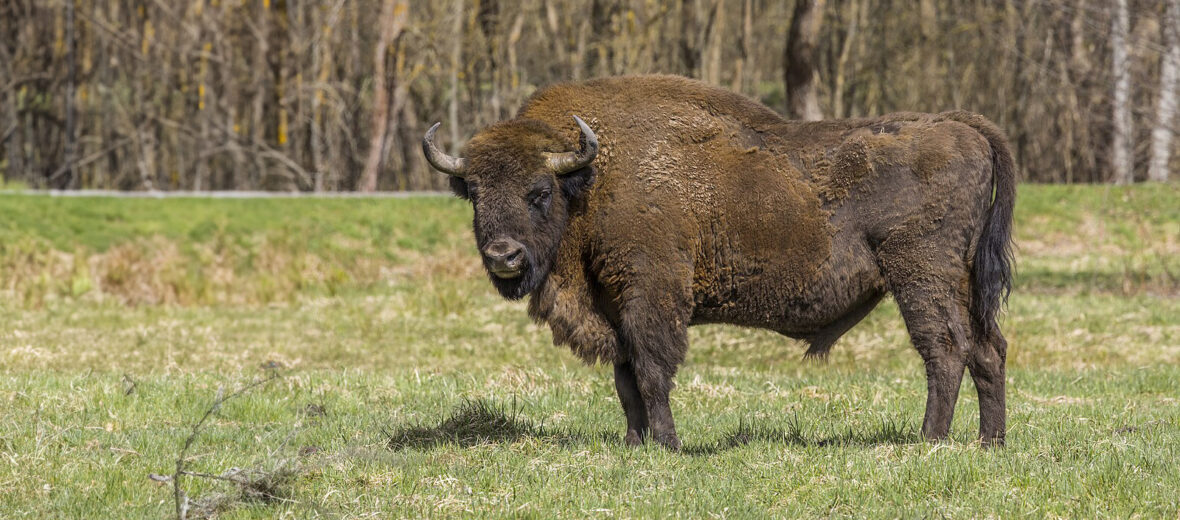
The European bison, aka European wood bison, zubr, European buffalo, or wisent, has a dispersed population found in Belarus, Kyrgyzstan, Lithuania, Poland, Romania, Russia, Slovakia, and Ukraine. They prefer broad-leaf forests, coniferous forests, and open grasslands. Unfortunately, these beasts face the threats of habitat loss at the hands of agriculture, roads, and railroads (which divide their territory and result in vehicle strike – being hit by vehicles); hunting; trapping; wars; civil unrest; military exercises; and invasive species (which can bring about various diseases and competition for food). The IUCN lists these creatures as Near Threatened. Their populations are increasing though, albeit slowly.
First the Stats…
Scientific name: Bison bonasus
Weight: Up to 2,028+ lbs.
Length: Up to 10.8 feet, plus up to a 3 foot tail
Height: Up to 6.9 feet
Lifespan: Up to 30 years
Now on to the Facts!
1.) As of 2020, there were an estimated 2,518 wild individuals scattered throughout their ranges.
2.) European bisons are the largest land mammal in Europe, followed by the European moose.
3.) These bison are diurnal (active during the day).
4.) They are social, among themselves, and dwell in herds of male only (bachelor herds) and mixed herds (harems – consisting of a dominant male and numerous females).
5.) The average herd size is up to 13 individuals. Bachelor obstinacies only contain 2 individuals.
But wait, there’s more on the European bison!
6.) Wisents may look bulky and cumbersome, but they are able to leap 6.56 foot fences and jump across 9.84 foot streams, from a standing position!
7.) A group of bison is called a herd, gang, or obstinacy.
Did you know…?
These giants were hunted to extinction back in the early 20th century. Luckily, numerous individuals were reared in zoos and later reintroduced to the wild, thus repopulating their species.
8.) European bisons do not hibernate during the winter months.
9.) Various grasses, leaves, and shoots make up their diet. This makes them herbivores (eat plant matter), with emphasis on being folivorous (eats leaves) or graminivorous (eats grass).
10.) A single adult individual can put away up to 70.55 lbs. of vegetation a day!
But wait, there’s still more on the European bison!
11.) Water needs to be consumed every day, and they will often use their immense weight and strong hooves to break open ice to reveal water during frozen winter months.
12.) Like other bison, they are polygynous (1 male mates with multiple females).
Did you know…?
Bison are fortunately, for now, not affected by the lethal chronic wasting disease (CWD).
13.) Through the months of August – October, the rutting season takes place. This is where the males will battle one another to win breeding rights with neighboring females.
14.) Females undergo up to a 264 day gestation (pregnancy) that yields a single calf.
15.) The calf is born predominantly precocial (mostly self sufficient), able to stand and walk just minutes after birth.
But wait, there’s still a tad more on the European bison!
16.) Calves spend most of their time resting on the ground, feeding from mom, and grazing.
17.) They are fully weaned at up to 12 months of age.
Now a Short European Bison Video!
Be sure to share & comment below! Also, check out the Critter Science YouTube channel. Videos added regularly!
Want to suggest a critter for me to write about? Let me know here.
Some source material acquired from: Wikipedia & IUCN
Photo credit: Charles J. Sharp



